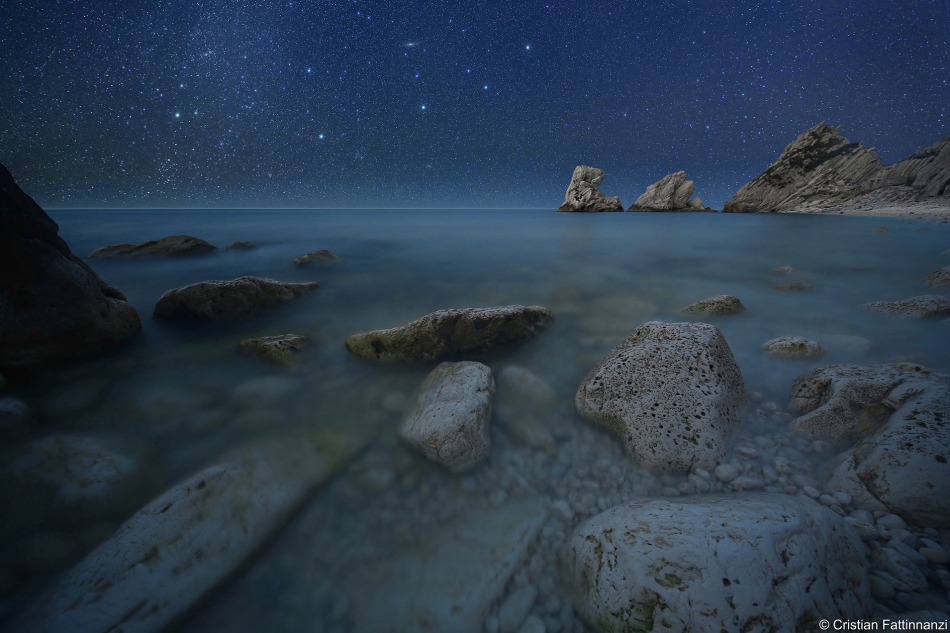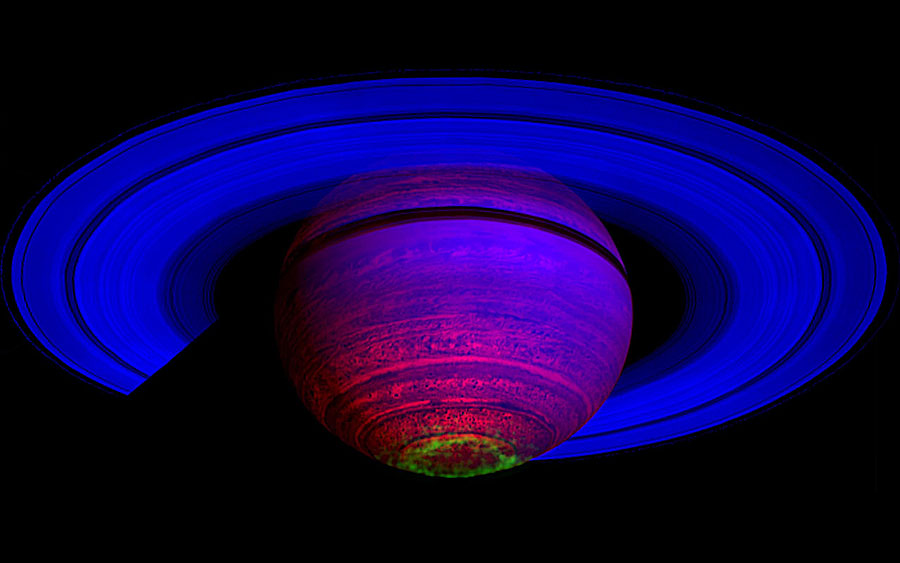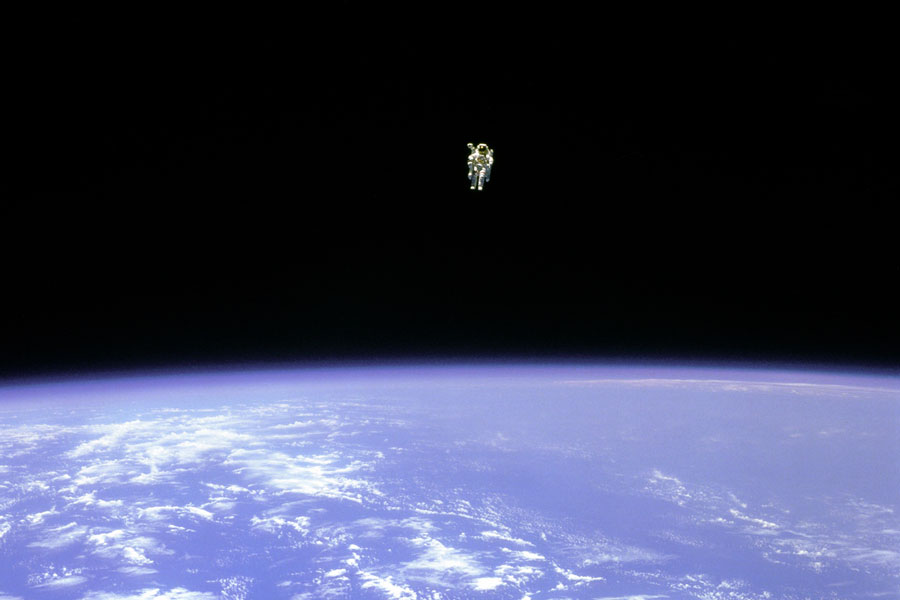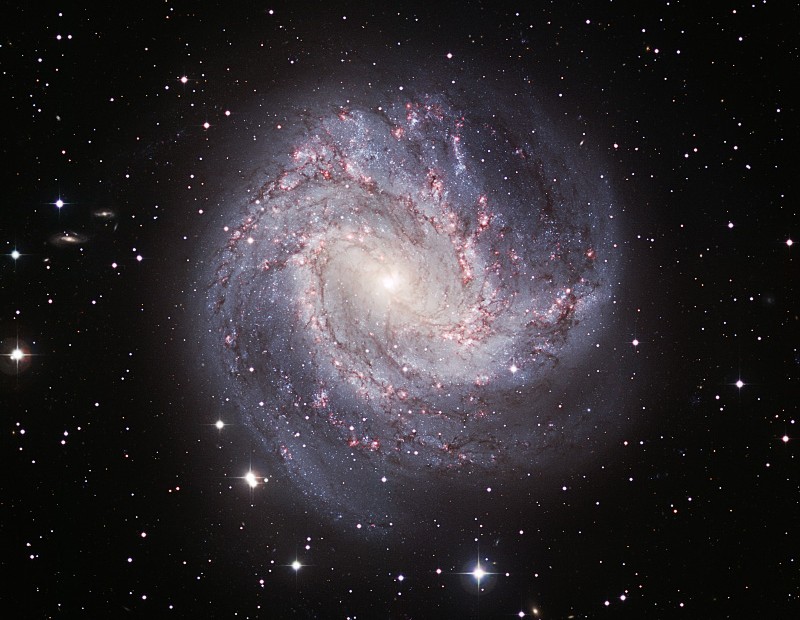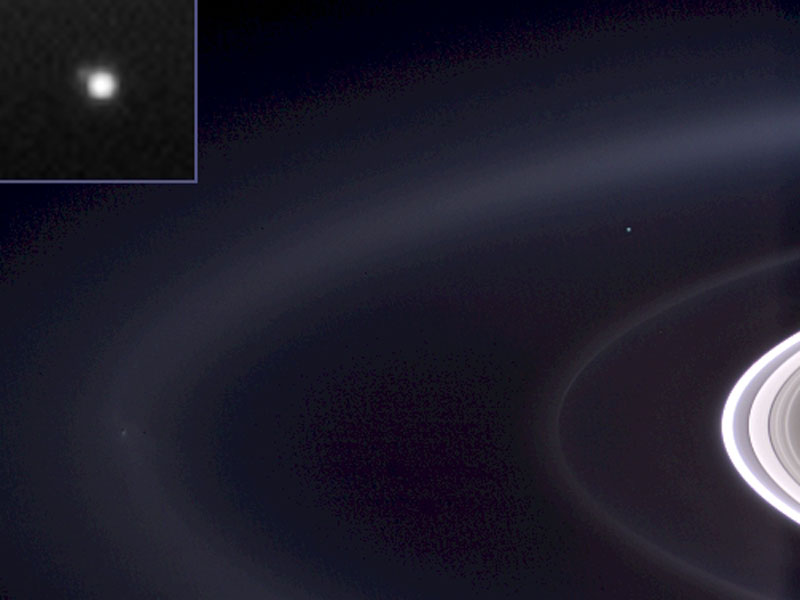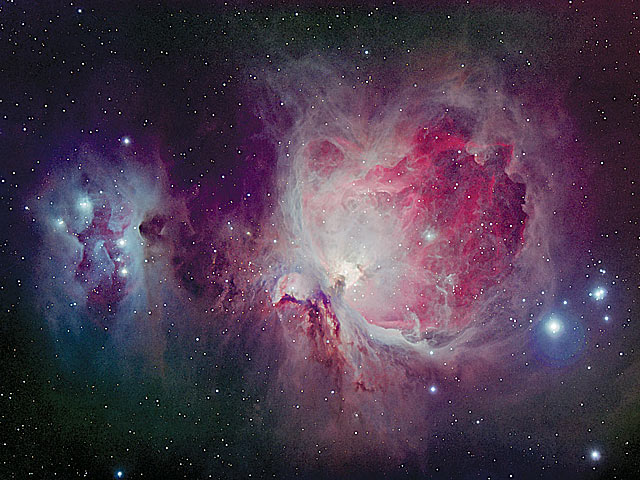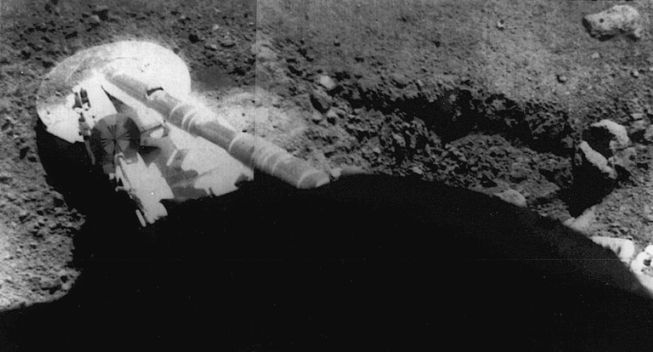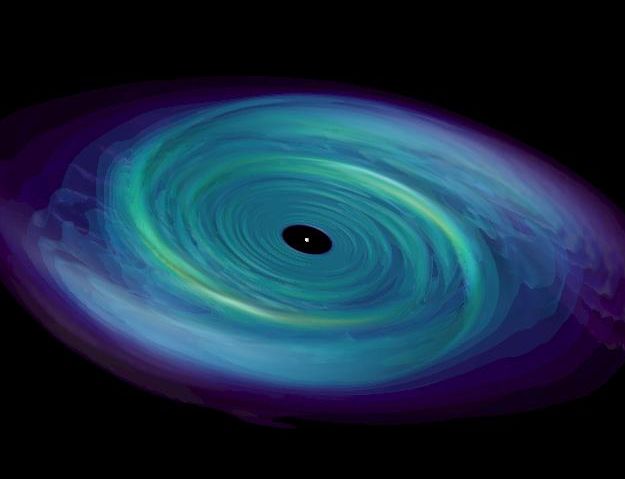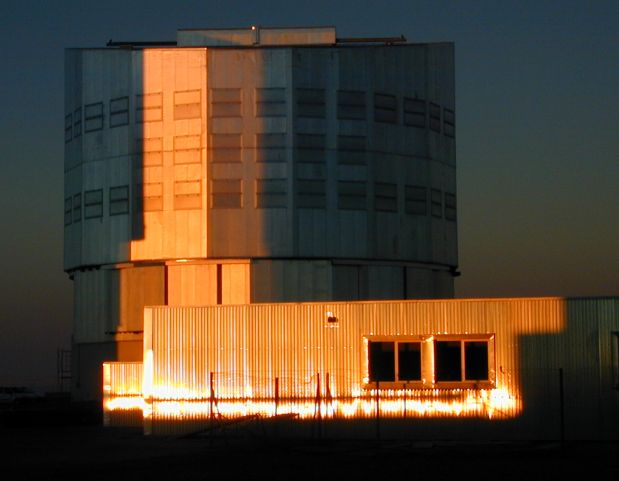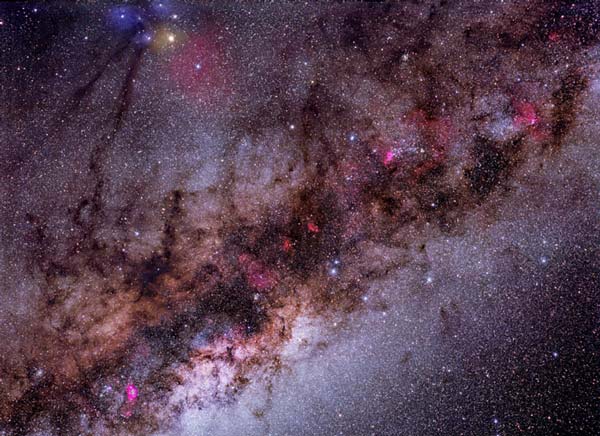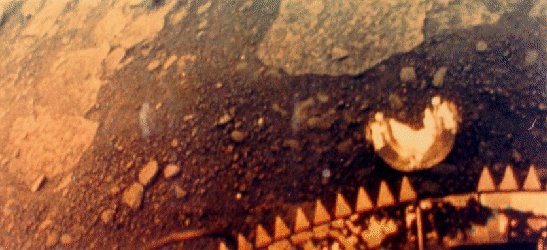2014 Taken from an Atlantic beach, Cape Canaveral, planet Earth, four identically framed digital images are combined in this night skyscape. Slightly shifted short star trails dot the sky, but the exposure times were adjusted to follow the flight of a Falcon 9 rocket. The September 21 launch delivered a Dragon X capsule filled with supplies to the International Space Station. Above the bright flare seen just after launch, the rocket's first stage firing trails upward from the left. After separation, the second stage burn begins near center with the vehicle climbing toward low Earth orbit. At the horizon, the flare near center records the re-ignition and controlled descent of the Falcon 9's first stage to a soft splashdown off the coast.
2013 How far can you see? The Andromeda Galaxy 2.5 million light years away is the most distant object easily seen by the unaided eye. Other apparent denizens of the night sky, stars, clusters, and nebulae, typically range from a few hundred to a few thousand light-years away and lie well within our own Milky Way Galaxy. Also known as M31, the Andromeda Galaxy is the faint smudge near top center of this Earth and skyscape, taken from eastern Italy, near Monte Conero on the Adriatic sea coast. From a few centimeters to a few million light-years, the picture demonstrates a stunning range of vision. Though galaxy and seaside rocks could be seen with the eye on that clear summer night, no camera captured this view in a single exposure. Because the stars trailed above the horizon while the picture was made, separate exposures tracking the stars were combined with one of rocks and cliffs made with the camera steadied to create the tantalizing scene.
2012 Cosmic dust clouds sprawl across a rich field of stars in this sweeping telescopic vista near the northern boundary of Corona Australis, the Southern Crown. Probably less than 500 light-years away and effectively blocking light from more distant, background stars in the Milky Way, the densest part of the dust cloud is about 8 light-years long. At its tip (upper right) is a group of lovely reflection nebulae cataloged as NGC 6726, 6727, 6729, and IC 4812. A characteristic blue color is produced as light from hot stars is reflected by the cosmic dust. The smaller yellowish nebula (NGC 6729) surrounds young variable star R Coronae Australis. Magnificent globular star cluster NGC 6723 is toward the upper right corner of the view. While NGC 6723 appears to be part of the group, it actually lies nearly 30,000 light-years away, far beyond the Corona Australis dust clouds.
2011
Click to play embedded YouTube video.
Image Credit: NASA; Acknowledgement: Infinity Imagined
2010 What drives auroras on Saturn? To help find out, scientists have sorted through hundreds of infrared images of Saturn taken by the Cassini spacecraft for other purposes, trying to find enough aurora images to correlate changes and make movies. Once made, some movies clearly show that Saturnian auroras can change not only with the angle of the Sun, but also as the planet rotates. Furthermore, some auroral changes appear related to waves in Saturn's magnetosphere likely caused by Saturn's moons. Pictured above, a false-colored image taken in 2007 shows Saturn in three bands of infrared light. The rings reflect relatively blue sunlight, while the planet itself glows in comparatively low energy red. A band of southern aurora in visible in green. Inspection of many more Saturnian images may well lead to an even better understanding of both Saturn's and Earth's auroras.
2009 At about 100 meters from the cargo bay of the space shuttle Challenger, Bruce McCandless II was farther out than anyone had ever been before. Guided by a Manned Maneuvering Unit (MMU), astronaut McCandless, pictured above, was floating free in space. McCandless and fellow NASA astronaut Robert Stewart were the first to experience such an "untethered space walk" during Space Shuttle mission 41-B in 1984. The MMU works by shooting jets of nitrogen and has since been used to help deploy and retrieve satellites. With a mass over 140 kilograms, an MMU is heavy on Earth, but, like everything, is weightless when drifting in orbit. The MMU was replaced with the SAFER backpack propulsion unit.
2008
2007 The dark expanse below the equator of the Sun is a coronal hole -- a low density region extending above the surface where the solar magnetic field opens freely into interplanetary space. Shown in false color, the picture was recorded on September 19th in extreme ultraviolet light by the EIT instrument onboard the space-based SOHO observatory. Studied extensively from space since the 1960s in ultraviolet and x-ray light, coronal holes are known to be the source of the high-speed solar wind, atoms and electrons that flow outward along the open magnetic field lines. The solar wind streaming from this coronal hole triggered colorful auroral displays on planet Earth begining late last week, enjoyed by spaceweather watchers at high latitudes.
2006 What's that pale blue dot in this image taken from Saturn? Earth. The robotic Cassini spacecraft looked back toward its old home world earlier this month as it orbited Saturn. Using Saturn itself to block the bright Sun, Cassini imaged a faint dot on the right of the above photograph. That dot is expanded on the image inset, where a slight elongation in the direction of Earth's Moon is visible. Vast water oceans make Earth's reflection of sunlight somewhat blue. Earth is home to over six billion humans and over one octillion Prochlorococcus.
2005 Towering pillars of cold gas and dark dust adorn the center star forming region of Sharpless 171. An open cluster of stars is forming there from the gas in cold molecular clouds. As energetic light emitted by young massive stars boils away the opaque dust, the region fragments and picturesque pillars of the remnant gas and dust form and slowly evaporate. The energetic light also illuminates the surrounding hydrogen gas, energize it to glow as a red emission nebula. Pictured above is the active central region of the Sharpless 171 greater emission nebula. Sharpless 171 incorporates NGC 7822 and the active region Cederblad 214, much of which is imaged above. The area above spans about 20 light years, lies about 3,000 light years away, and can be seen with a telescope toward the northern constellation of the King of Ethiopia (Cepheus).
2004 The Great Nebula in Orion is a colorful place. Visible to the unaided eye, it appears as a small fuzzy patch in the constellation of Orion. Long exposure, digitally sharpened images like this, however, show the Orion Nebula to be a busy neighborhood of young stars, hot gas, and dark dust. The power behind much of the Orion Nebula (M42) is the Trapezium - four of the brightest stars in the nebula. Many of the filamentary structures visible are actually shock waves - fronts where fast moving material encounters slow moving gas. The Orion Nebula spans about 40 light years and is located about 1500 light years away in the same spiral arm of our Galaxy as the Sun.
2003 "Safe!" In September 1967 (during regular season play), the Surveyor 5 lander actually slid several feet while making a successful soft landing on the Moon's Mare Tranquillitatis. Equipped with television cameras and soil sampling experiments, the US Surveyor spacecraft were intended to determine if the lunar surface at chosen locations was safe for the planned Apollo landings. Surveyor 5 touched down on the inside edge of a small crater inclined at about 20 degrees. Its footpad slipped and dug the trench visible in the picture. Covered with dusty lunar soil, the footpad is about 20 inches in diameter.
2002 Don't be fooled by the familiar symmetry. The graceful spiral structure seen in this computer visualization does not portray winding spiral arms in a distant galaxy of stars. Instead, the graphic shows spiral shock waves in a three dimensional simulation of an accretion disk -- material swirling onto a compact central object that could represent a white dwarf star, neutron star, or black hole. Such accretion disks power bright x-ray sources within our own galaxy. They form in binary star systems which consist of a donor star (not shown above), supplying the accreting material, and a compact object whose strong gravity ultimately draws the material towards its surface. For known x-ray binary systems the size of the accretion disk itself might fall somewhere between the diameter of the Sun (about 1,400,000 kilometers) and the diameter of the Moon's orbit (800,000 kilometers). One interesting result of the virtual reality astrophysics illustrated here is that the simulated disk develops instabilities which tend to smear out the pronounced spiral shocks.
2001 Spiral galaxy M33 is a mid-sized member of our Local Group of Galaxies. M33 is also called the Triangulum Galaxy for the constellation in which it resides. About four times smaller (in radius) than our Milky Way Galaxy and the Andromeda Galaxy (M31), it is much larger than the many of the local dwarf spheroidal galaxies. M33's proximity to M31 causes it to be thought by some to be a satellite galaxy of this more massive galaxy. M33's proximity to our Milky Way Galaxy causes it to appear more than twice the angular size of the Full Moon, and be visible with a good pair of binoculars. The above high-resolution image highlights light emitted by hydrogen in red and oxygen in blue. It was taken to help separate stars from emission nebulae, and therefore help study how galaxies form stars.
2000 Pictured above on September 3rd, the enclosure for the 8.2 meter telescope christened Yepun glints dramatically in the light of the setting sun. Later that evening, under dark skies at Paranal Observatory, Chile, astronomers and engineers successfully captured Yepun's first light images, making Yepun the fourth and final unit of the European Southern Observatory's Very Large Telescope (VLT) array to reach this milestone. Ultimately, the light from the three other 8.2 meter unit telescopes (Antu, Kueyen, and Melipal) will be combined with Yepun's to achieve an effective aperture of 16.4 meters -- creating the world's largest optical telescope. But the next major step will be to combine beams from two of the telescopes creating an interferometer. The upper part of the mostly subterranean interferometer lab is the building in front of the telescope enclosure. The VLT unit telescope names have been taken from the Mapuche language. Originally thought to refer to the bright star Sirius, the word Yepun is now believed by linguists to mean Venus or evening star.
1999 The disk of our Milky Way Galaxy is home to hot nebulae, cold dust, and billions of stars. The red nebulae visible in the above contrast-enhanced picture are primarily emission nebulae, glowing clouds of hydrogen gas heated by nearby, bright, young stars. The blue nebulae are primarily reflection nebulae, clouds of gas and fine dust reflecting the light of nearby bright stars. Perhaps the most striking, though, are the areas of darkness, including the Pipe Nebula visible on the image top left. These are lanes of thick dust, many times containing relatively cold molecular clouds of gas. Dust is so plentiful that it obscures the Galactic Center in visible light, hiding its true direction until discovered early this century. The diffuse glow comes from billions of older, fainter stars like our Sun, which are typically much older than any of the nebulae. Most of the mass of our Galaxy remains in a form currently unknown.
1998 Albert Einstein (1879-1955) is considered by many the greatest astrophysicist. He is pictured here in the Swiss Patent Office where he did much of his great work. Einstein's many visionary scientific contributions include the equivalence of mass and energy (E=mc^2), how the maximum speed limit of light affects measurements of time and space (special relativity), and a more accurate theory of gravity based on simple geometric concepts (general relativity). One reason Einstein was awarded the 1921 Nobel Prize in Physics was to make the prize more prestigious.
1997 The Plane of the Ecliptic is illustrated in this Clementine star tracker camera image which reveals (from right to left) the Moon lit by Earthshine, the Sun's corona rising over the Moon's dark limb, and the planets Saturn, Mars, and Mercury. The ecliptic plane is defined as the imaginary plane containing the Earth's orbit around the Sun. In the course of a year, the Sun's apparent path through the sky lies in this plane. The planetary bodies of our solar system all tend to lie near this plane, since they were formed from the Sun's spinning, flattened, proto-planetary disk. The snapshot above nicely captures a momentary line-up looking out along this fundamental plane of our solar system.
1996 Today is Shannon Lucid's first day on Planet Earth in six months. Her stay aboard Russia's Mir Space Station was of record length - the longest stay of any American in space ever. During her time in orbit around the Earth, Lucid, a biochemist, did many things including experiments on the effect of weightlessness on the human body. Pictured above, Lucid greets the astronaut that will replace her on Mir, John Blaha.
1995 This image is part of the first color panoramic view from Venus. It was transmitted by a TV camera on the Soviet Venera 13 lander which parachuted to the surface on March 1, 1982. Venus' clouds are composed of sulfuric acid droplets while its surface temperature is about 900 degrees Fahrenheit (482 degrees C) at an atmospheric pressure of 92 times that of sea-level on Earth. Despite these harsh conditions, the Venera 13 lander survived long enough to send back a series of images and perform an analysis of the Venusian soil. Part of the lander itself is visible in the lower right portion of the image. An earlier Soviet Venus lander, Venera 7 (1970), was the first spacecraft to return data from the surface of another planet.
| << Previous | Index | Next >> |

